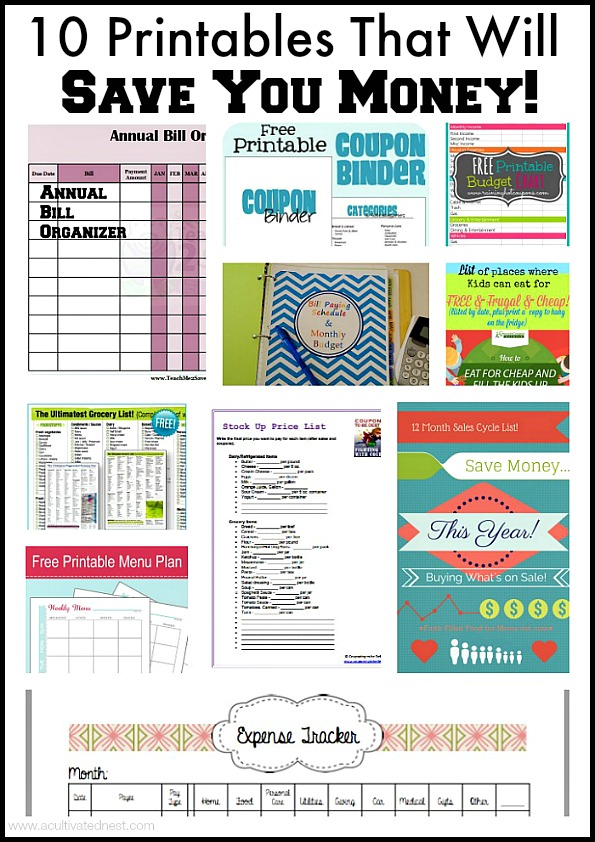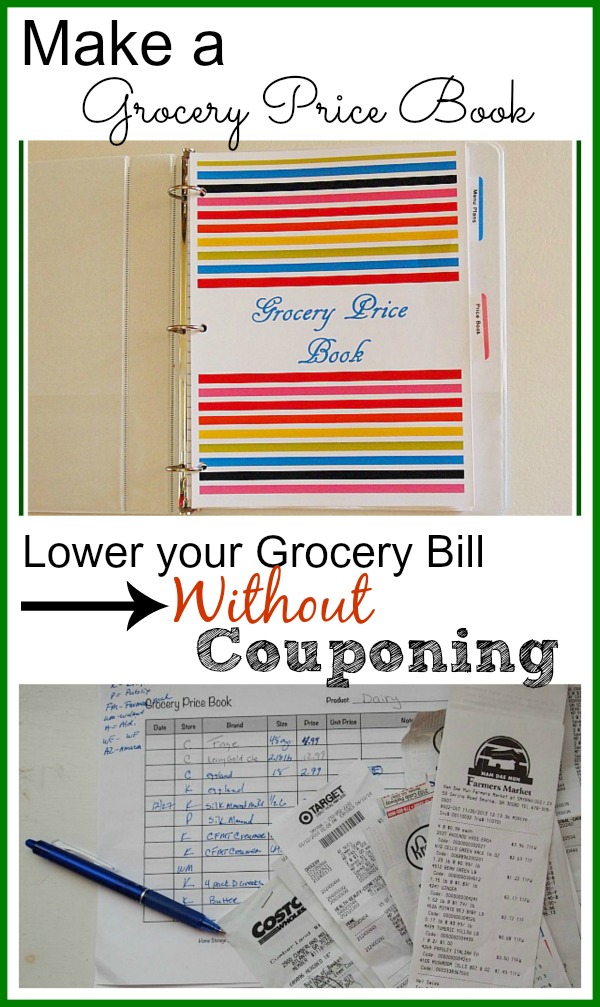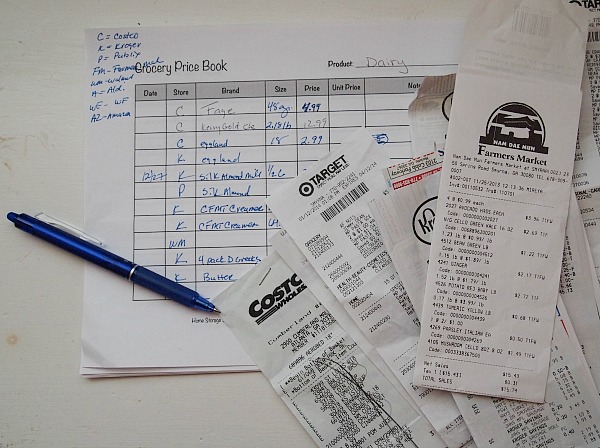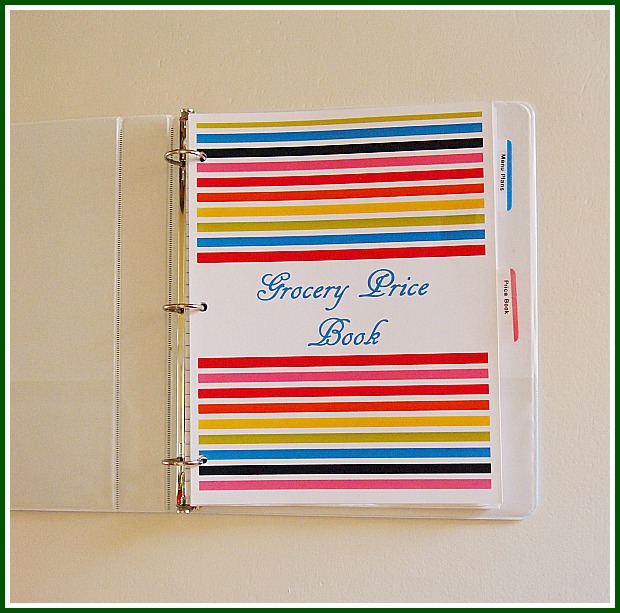I want to share with you something that has really been helping me save money on my grocery bill! Actually, I’ve re-introduced two strategies that are helping me with my budget. I made a grocery store price book and I’m back to weekly menu planning! In this post I’ll just explain the ins and outs of How To Make A Grocery Store Price Book and I’ll do menu planning in another post.
How To Make A Grocery Store Price Book
Disclosure: This post may contain affiliate links to Amazon and/or Etsy, which means that I may earn a small commission from some of the links in this post. Please see our Disclosure Page for more information.
This is definitely an old school strategy to saving money. I learned about making a grocery price book many, many…many years ago from Amy Dacyzyn’s The Complete Tightwad Gazette ( great book if you haven’t already read it and a good one to re-read even if you have). A few months ago I started keeping a price book again (haven’t had one in about 8 years).
Grocery prices have gotten so high that what I used to consider the regular price is now the sale price! Plus there are so many more avenues (online and brick and mortar) for me to shop for groceries that I decided that a grocery price book was the only way to keep track and to know what a good deal is at least on our every day essential items.
One day boneless chicken breasts were $1.69 lb and then they jumped to $2.29 at the store with my every day low prices (1.99 is the sale price at Kroger but this store had boneless chicken breast everyday for $1.69)! It’s all crazy now and I can’t possible “remember” what’s a good price and what isn’t these days!
What is a Grocery Store Price Book
For those of you that have never heard of this concept, a grocery store price book is just a place where you track the prices of items that you normally buy.
Benefits of Keeping a Price Book
Grocery spending is one of the most common areas that people cut when they’re trying to reduce costs.
- A price book will you allow you to compare prices and make informed buying decisions (how many times have “sale” items in store ads really been the “always” price or a penny or two cheaper = sales gimmick)
- A price book will also help you track sales cycles for items
- A price book will alert you to a change in the size of packaging (downsizing is something manufacturers are doing more and more)
- A price book can save you money without using a coupon since you will know what the lowest price for that item is and how often it’s at it’s lowest price (that’s when you stock up)
If you can couple the lowest price with a coupon that’s even better. But just buying at the lowest price is good enough for many people.
You can go old school like me and use paper and pencil to track prices. I happen to like using binders for different things. You can also use a tabbed area in your planner(Filofax etc).
Some people share their price books online so can check to see if someone in your area has already tracked some prices by “grocery price book your area” and see if anything comes up.
Digital Price Tracking
You can make an excel spreadsheet. Make a google document. If you have a smartphone you might try apps like Evernote, Out of Milk, Mighty Grocery, ValueTracker , Sharky Shopping and I’m sure there are tons more (if you use an app as a price book leave the name in the comments).
High tech or low tech doesn’t matter – anyway that works for you! Just make sure whatever way you choose you are able to update it as needed.
How I made my price book
- I thought the easiest way would be to keep my grocery receipts from various stores for a month and then transfer the amounts onto paper. I also used my local sales fliers. You can also visit the stores that you shop at and go aisle by aisle writing down the prices of things you normally buy.
- Decide if you want to keep your price book organized by store, product or category (ex. dairy, boxed foods, fresh fruit etc). I do category.
- Write down the store (make yourself a code so you don’t have write out the name each time) item, size, price, date of purchase and make a note if this was a sale price or regular retail price (this way you can track the sales cycle of a product). Unit price is also important to know. Add whatever info is important to you.
- Start with just your top 10-15 items and add more as time permits. Trying to do everything that you always buy at once will take a chunk of time and you’ll probably burn out before finishing this project. Baby steps! I’ve been adding to mine for months!
How to use your price book
You will always know what the lowest price is. So when you’re looking at a sales ad you’ll know if the sale is worth it or not.
When you see a particular item on sale at a great price, then you’ll know it’s time to stock up!
When you’ve been tracking your prices long enough, you’ll start to see the sales cycle which will help you figure out how much to buy until the next sale. That way you are always stocking up at the lowest price.
I found out that some stores that I thought had the best price for an item didn’t and some stores that I thought had high prices had the best prices on some items. Go figure!
Even if you only shop at one store, it’s still good to look at Amazon (Amazon Pantry for example often has deals – affiliate link) and other online places that offer groceries (Zaycon etc). Especially if you have special dietary challenges. At the moment, Amazon has the lowest price for certain of our gluten-free grocery items (much lower than Kroger even).
I wouldn’t know that if I didn’t know my prices!
Printable Grocery Store Price Sheet Resources
Price Book Printable by Home Storage Solution pdf
Organized Home Price Book Printable
Dollar Stretcher pdf price book pages (3×5, 5×7 & full sheet sizes)
Store printable @ Grocery Shop For Free
Money Saving Mom Price Book Printables
It takes a bit of initial effort but it’s worth it in the end. Be a smart consumer and know your prices!
Do you use a price book?
****This post may contain affiliate links. Please see our Disclosure & Privacy Policy for more detailed information.****
You might also like: 10 Printables That Will Keep You Organized & Save You Money





I love this idea of price comparison and keeping track. Thank you.
I am getting closer everyday to making one. Even though I usually get the best prices around and use coupons. I do need to make a price book so I won’t run out of sale cheese ($1.49) and have to pay $2.98 for that one week when I run out before the sale cycle comes around.
Thanks, this is a great idea!
I’m going to try this! Thanks for the idea!
What gets me is that I’ll go to buy my cereal. It might be the same price, but when I get it home I see that it is smaller than the one I bought last time! Food is getting so high. I can’t even buy fresh fruit right now. Thanks for this great advice.
Brenda
What’s in your Moving binder? We have an impending move on the horizon and want to approach it with as much organization as possible so let me know if you have any tips!
There’s nothing in it yet. 🙂 I’ll probably start using it in mid-Feb when we gear up for listing our house. I usually use a composition book but since I’m using binders for several other things I thought I’d switch to a binder for our move. I usually keep anything related to the move – projects we need to finish – mover quotes – projects at the new place – anything related to preparing for and actually moving.
This is brilliant in its simplicity. I’m one of those people who rarely know how much things cost. For some reason, only a few products stick out in my mind. Pistachios for one. I remember when they were $4 a lb, now they’re twice that, easily!
Like Jessica, I’d love to know what’s in your moving binder. We have a move in a couple of months. Inquiring minds want to know 😉
Thanks for the reminder. I tried to do this years ago but I am now in a different place and I think it would be very helpful. I use the Internet to help me coupon, but often it is things I don’t want or need. Week to week I mostly buy perishables and keep my pantry stocked with staples. My cooking these days is simple and from scratch. I think a price book would be very helpful for these items.
I think you’ll find it very useful for keeping track of at least your most used ingredients.
I’ve been using a pricebook for years and after trying various methods (low and high-tech) I have come back to my favorite simple method. I use an alphabet-tabbed address book and a pencil. I list the food products under the alpha-tabs and it makes it super simple to look them up while I’m shopping to compare a price or update/add a price. I try to keep it updated from receipts and things I note while doing my regular shopping but I also look it over once a year and try to get out and do a pricing trip to keep it up-to-date.
An entry might look like this:
Green beans, canned
Green Giant 12 x 14.5 oz 6.99 .04/oz Costco 5/13
Store brand 14.5 oz .49 .034/oz Aldi 2/13
Now I need to go reread Amy Dacyczyn’s Tightwad compendiums.
That’s a great idea! They come in all sizes so you could easily find one that fits in a purse. Yes, I like to skim my Amy D books every year. It’s a great way to stay motivated and sometimes I find something new to try.
Thanks for dropping by!